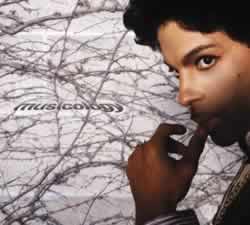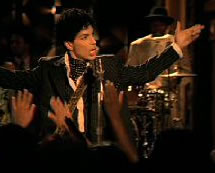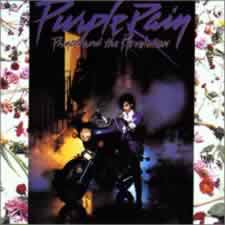
Many reviewers received Prince’s recent album and tour as a return to form, a “comeback.” In classic fashion, Prince bristled at this appellation, and rightly so: there are numerous reasons why Musicology (2004) should not be characterized as a comeback album. On the surface, Prince has “come back” in a very real way. After a very public feud with his former record label Warner Brothers, and a much derided name change, Prince had little in the way of favorable press or a mainstream hit, in quite some time. In this light, the well-deserved attention that Prince’s Musicology album and tour garnered makes the project seem like a return to form, and a refutation of the critical stance that Prince is past his prime or is no longer relevant within a music industry whose racial boundaries he boldly challenged in the 1980s. On the other hand, considered in light of Prince’s many releases since the end of his tenure at Warner Brothers, Musicology is but a drop in the bucket.
Prince has never ceased recording and releasing songs and albums, though many of them have only been available through his website <www.npgmusicclub.com>. He has also toured continuously for the last decade, and the strength of his live act remains undiminished. Prince’s millennial New Year’s Eve concert at his Paisley Park complex showed him in top form, and the resulting Pay Per View broadcast was released on DVD to good reviews. More recently, Prince supported his adventurous, jazz-influenced 2001 album The Rainbow Children with the One Nite Alone tour (2002), which drew capacity crowds and critical praise around the country and was released as a boxed set that has sold briskly despite a high price tag. Musicology’s songs are based upon musical influences that have always been in Prince’s work, and their particular deployment displays the same mix of R&B and pop production styles as his last major-label partnership, Rave Un2 the Joy Fantastic (1999). The songs on internet-released albums such as The Slaughterhouse(2004) and The Chocolate Invasion (2004) have much in common with the material on Musicology both in terms of thematic focus and stylistic influences, and it is largely the lack of major-label publicity and distribution that prompted many reviewers to ignore them.1 Yet the comeback label has stuck in the popular press.
The trade press, meanwhile, has spent more time discussing the novel business model Prince adopted than the music itself. Including a “free” copy of the album with each concert ticket and then counting those as “sales” in the SoundScan reports certainly seems like a transparent ploy to boost the album’s chart position. However, the SoundScan reports do not support this conclusion. The album debuted at number three on the Billboard 200 album chart, a feat that, according to Billboard, it would have accomplished even without including concert-distributed copies of the album as sales (the numbers have been reported separately) (Christman and Mayfield 1). As of this writing the album has re-entered the top-ten, marking fourteen weeks on the charts. Sales figures aside, this controversial business model would arguably not have saved a bad album from obscurity.
Musicology is neither a comeback nor a prop in an industry game of SoundScan cat-and-mouse. Yet the fact that journalists are focusing on the comeback question (either to support or debunk it) points to a discursive white elephant underlying current Prince reception. The question remains whether Prince, as an artist of a certain vintage, will continue to innovate and produce hits or slide into that sector of the market that relies on nostalgia and licensing deals as the primary revenue streams. For the balance of this review, I will argue for the continuing relevance of Prince’s music by discussing the socio-cultural issues with which his music engages, both lyrically and stylistically. Musicology’s success is not merely the result of synergistic business strategies, coming hard on the heels of his Rock and Roll Hall of Fame induction and remaining on the charts through statistical sleight-of-hand. The album does not represent a sea-change in his work, and the runaway success of the Musicology tour—which set an attendance record over five sold-out shows at Los Angeles’s Staples Center—is not a function of narcissistic nostalgia. The tour demonstrates how Prince can use his new material to inflect and comment on earlier music, both his own and others’. Throughout Musicology the listener can hear the sounds of an artist negotiating the changing terrain of musical race relations in America, and Prince’s changing role within that field: after being the flag-bearer of genre synthesis and racial hybridity in his early career, Prince now occupies a more patrician position, guarding the flame of black music in America
Musicology contains twelve songs, ranging stylistically across both contemporary and past styles of R&B and rock. “Buying” the album is not a simple task however, as Prince has been producing “electronic b-sides” to accompany the album’s singles, and releasing them only through his NPGMusic Club website. Though it may be conventional wisdom to regard Prince’s flood of outtakes and b-sides with suspicion, they succeed in extending and enriching themes of social protest and romantic stability. One example is “The United States of Division,” the b-side to Musicology’s anti-war single “Cinnamon Girl.” “Cinnamon Girl” uses a rock idiom suggestive of 1980s new-wave (tense guitar-accompanied verses followed by synth-heavy choruses, framed with a straight duple meter and unrelenting minor-mode harmony), lyrically exploring the complex issues surrounding ethnicity in a post-9/11 world and stressing the power of prayer, hinting at the monotheism of both Christianity and Islam as a common ground for understanding.“The United States of Division” presents simplistic anti-war lyrics (“everybody stop fighting”), while enacting all the cold complexity of contemporary American/Middle-Eastern relations with a hard and extremely funky polyrhythmic groove, stark instrumental texture, and ambiguously modal hook.2
The lushly romantic slow-jam “Call My Name” finds Prince paying homage to the stability of identity garnered from being in a long-term monogamous relationship, while its electronic b-side, a “demo,” entitled “Silver Tongue,” uses a jazz-flavored solo piano reminiscent of Prince’s troubled piano ballads—“Condition of the Heart” (Around the World in a Day) or “Sometimes it Snows in April” (Parade)—to support intensely cynical lyrics about betrayed trust (“such a sad way to lose someone…the song and dance that hides your gun / from those who buy the silver from your tongue…”). Anti-war sentiment and romantic stability are two of the recurring themes of this album, which also includes touches of self-effacing humor (the twelve-bar blues number “On the Couch”) and bombastic rock-opera (“A Million Days,” “Marrying Kind,” and “If Eye Was the Man in Your Life,” the latter two of which recall Prince’s multi-song suite “Three Chains ‘O’ Gold” from the self-titled Love Symbol Album). But there is one more overarching theme that Prince touches on directly in the title track: nostalgia for a musical past.

“Musicology” is one of only a handful of album tracks that Prince routinely performs in his tour appearances (he opens the show with it). Lending the song even more weight, Prince includes a video of it on the store-bought version of the album. Considered together, the aural and visual images present a nostalgic portrait of a sort of black musical utopia located in an anachronous musical past. Prince appears in a retro-themed performance, set in an art-deco theater peopled with zoot-suited men and women in “New-Look” dresses and pillbox hats, even going so far as to include a pair of tap-dancers in matching V-necked sweaters. Spliced with this footage is a parallel storyline of a young boy who first purchases the new Prince forty-five, and then lip-syncs along to the song in a bedroom festooned with posters of African-American musical icons of the 50s, 60s, and 70s.
The song’s groove supports this retrospective theme (especially in live performance, where the horns dominate), and displays precisely the same kind of “in-the-pocket” playing that characterizes James Brown’s musical innovations of the late 1960s (Ramsey 11; Danielsen 75). Specifically, the instruments—bass, drums, guitar, keyboard, and horns—each play unchanging ostinati that join like puzzle pieces, creating a complex composite rhythm and embellishing the unchanging harmony of the song. This technique is clearly audible in the judiciously interlocking sounds of drummer John Blackwell’s fluttering snare-drum ghost-strokes and the dry, high-pitched bass line (Listen to “Musicology”). To this mix Prince (like Brown) adds horn, keyboard and rhythm guitar, all of which stay resolutely in the pocket of the groove, lending the song the affect of tasteful restraint that distinguishes 1960s funk from its looser descendents (e.g. George Clinton and P-Funk, who are also important influences on Prince’s work). Not content with retro-pastiche, however, Prince slowly builds the song’s dynamic intensity by layering counter-melodies incrementally until, by the last verse, he has created a perfect analogue to the raucous energy of his live shows, complete with P-Funk-style synthesizer stabs and backing vocals evocative of gospel.
James Brown has always been among Prince’s primary musical inspirations. This influence has been enriched by New Power Generation member and former James Brown saxophonist Maceo Parker (former P-Funk trombonist Greg Boyer is in the band as well, although Prince more often foregrounds Parker’s musical personality). And while there are other genre references on the album,3 the theme of nostalgia looms over Musicology for a number of reasons. The title track and video send a clear message: “true funk” is located in the past (or at least in a present more informed by the past) and played by live musicians rather than on turn-tables. In his live performances, Prince often foregrounds his excellently pedigreed horn section, which lends his back-catalog the feel of an old-school rhythm and blues review. One interesting example of this is how the song “Life ‘O’ the Party” has changed over the course of the tour. A reflexive song about party music in the tradition of other Prince grooves like “Housequake” (Sign ‘O’ the Times) and “Jam of the Year” (Emancipation), the album version of “Life ‘O’ the Party” is spare in texture, the vocal melody little more than a reciting tone accompanied by a two-note piano hook over a subwoofer-devouring drum machine groove.4 (Listento “Life ‘O’ The Party”) In concert, Prince changes“Life ‘O’ The Party” drastically: where there had been coldly minimal textures enlivened by occasional horn interjections, Prince juxtaposes the song’s vocals over the metronomic ticking drums and higher-pitched bass octaves of James Brown’s “Hot Pants,” a song whose unmistakable horn-riff turnaround appears again near the end of the concert.

The past as a musical topic has often been used as a palliative to this or that bloated trend within the music industry. For instance, as 1970s progressive rock ballooned songs into multi-section suites with long keyboard solos, punk rock turned to back-to-basics amateurism based on reviving 1950s and 60s garage rock. Yet overemphasis on the musical past can be politically conservative, even paralytic, leading to the creation and defense of musical canons that creak under their own weight, choking out innovative new work while they fail to address the needs of contemporary society. It is perhaps for this reason that the reception of Prince’s current project has been so charged: in the wake of Prince’s induction into the rock ‘n’ roll hall of fame, and the 20th anniversary of what was arguably his commercial zenith (1984’s Purple Rain), critics are both slavering for a glimpse of the artist past his prime and desperate for evidence that he is not. But the model of nostalgia with which Prince has furnished his audience defies such categorization. I hear not the pathetic nostalgia of a narcissistic artist limping into middle age on the crutches of past hits, but rather the purposeful nostalgia of an artist paying homage to his musical forbears, and using this knowledge to move forward. Even as Prince first brought his transgressive fusion of punk and new-wave musical styles to the attention of mainstream America in the 1980s, scholars such as Nelson George recognized him as one of “the decade’s finest historians” (194). Considered in tandem, Prince’s Musicology album and tour are a portrait of an artist who is firmly rooted in the history of African-American popular music, using his subject position not as an end in itself, but as a platform for exploring political and personal issues relevant in today’s America.
Griffin Woodworth
University of California, Los Angeles
WORKS CITED
Discography
Prince. Purple Rain. Warner Brothers 25110-2, 1984.
Prince. Around the World in a Day. Paisley Park / Warner Brothers 2-25286, 1984.
Prince. Parade (Music from the Motion Picture Under the Cherry Moon). Paisley Park / Warner Brothers 2-25395, 1986.
Prince. Sign ‘O’ the Times. Paisley Park / Warner Brothers 25577, 1987
.
Prince. Prince and the New Power Generation / The Love Symbol Album. Paisley Park / Warner Brothers 2-45037, 1992.
Prince. Emancipation. NPG / EM 54982, 1996.
Prince. Rave Un2 the Joy Fantastic. NPG / Arista 14624, 1999.
Prince. The Rainbow Children. NPG / Redline 70004, 2001.
Prince. One Nite Alone…Live! NPG 7070, 2002.
Prince. Musicology. NPG / Columbia 92560, 2004.
Books and Articles
Christman, Ed and Geoff Mayfield. “Prince CD Sparks Debate.” BillboardMay 8, 2004. 1, 68.
Conniff, Tamara. “Prince will bring his ‘Musicology’ tour back to Los Angeles.” The Hollywood Reporter May 20, 2004.
Danielsen, Anne. “Presence and Pleasure: A Study in the Funk Grooves of James Brown and Parilaiment.” Ph.D. diss., University of Oslo, 2001.
DeCurtis, Anthony. “Prince, ‘Musicology’: 4-Stars.” Rolling Stone April 29, 2004. 75-6.
George, Nelson. The Death of Rhythm & Blues. New York: Plume, 1988.
Ramsey, Guthrie. “Who Hears Here? Black Music, Critical Bias, and the Musicological Skin Trade.” The Musical Quarterly 85 (Spring, 2001). 1-52.
- The Slaughterhouse is largely comprised of previously released tracks on the internet dating from the first two years of the New Power Generation Music Club’s existence, so the 2004 release date is somewhat misleading. ↩
- Anthony DeCurtis claims “Cinnamon Girl” borrows its title from a Neil Young song and a deft hook from the mid-Eighties to explore racial and ethnic differences in a post-9/11 world (DeCurtis 76). ↩
- The influence of singer-songwriter Joni Mitchell lingers in the ballad “Reflections”; “On the Couch” is straight 12-bar blues with touches of barrelhouse piano; and the rocker “A Million Days” recalls Carlos Santana’s soaring guitar style, to say nothing of the lyrical references to 1960s and 70s funk icons such as Earth Wind & Fire and Sly Stone in “Musicology.” ↩
- This is one of two songs on the album on which Prince tips his hat to contemporary hip-hop, at least in terms of production style, the other being the cryptic quasi-rapped “Coma, Pimp & Circumstance.” ↩
